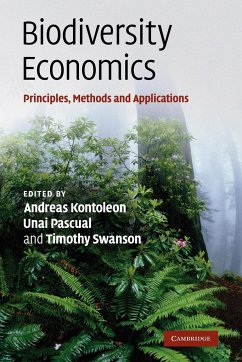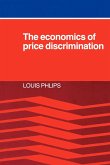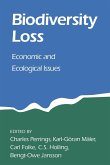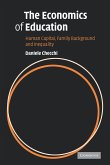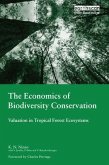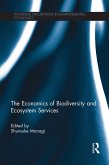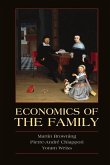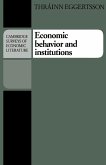Biodiversity Economics
Principles, Methods and Applications
Herausgeber: Kontoleon, Andreas; Swanson, Timothy; Pascual, Unai
Biodiversity Economics
Principles, Methods and Applications
Herausgeber: Kontoleon, Andreas; Swanson, Timothy; Pascual, Unai
- Broschiertes Buch
- Merkliste
- Auf die Merkliste
- Bewerten Bewerten
- Teilen
- Produkt teilen
- Produkterinnerung
- Produkterinnerung
An examination and evaluation of the problem of various forms of biodiversity loss.
Andere Kunden interessierten sich auch für
![The Economics of Price Discrimination The Economics of Price Discrimination]() Louis PhlipsThe Economics of Price Discrimination26,99 €
Louis PhlipsThe Economics of Price Discrimination26,99 €![Biodiversity Loss Biodiversity Loss]() Charles Perrings / Karl-Goran Maler / Carl Folke / C. S. Holling / Bengt-Owe Jansson (eds.)Biodiversity Loss49,99 €
Charles Perrings / Karl-Goran Maler / Carl Folke / C. S. Holling / Bengt-Owe Jansson (eds.)Biodiversity Loss49,99 €![The Economics of Education The Economics of Education]() Daniele ChecchiThe Economics of Education47,99 €
Daniele ChecchiThe Economics of Education47,99 €![The Economics of Biodiversity Conservation The Economics of Biodiversity Conservation]() K. N NinanThe Economics of Biodiversity Conservation63,99 €
K. N NinanThe Economics of Biodiversity Conservation63,99 €![The Economics of Biodiversity and Ecosystem Services The Economics of Biodiversity and Ecosystem Services]() The Economics of Biodiversity and Ecosystem Services63,99 €
The Economics of Biodiversity and Ecosystem Services63,99 €![Economics of the Family Economics of the Family]() Martin BrowningEconomics of the Family63,99 €
Martin BrowningEconomics of the Family63,99 €![Economic Behavior and Institutions Economic Behavior and Institutions]() Thrainn EggertssonEconomic Behavior and Institutions57,99 €
Thrainn EggertssonEconomic Behavior and Institutions57,99 €-
-
-
An examination and evaluation of the problem of various forms of biodiversity loss.
Hinweis: Dieser Artikel kann nur an eine deutsche Lieferadresse ausgeliefert werden.
Hinweis: Dieser Artikel kann nur an eine deutsche Lieferadresse ausgeliefert werden.
Produktdetails
- Produktdetails
- Verlag: Cambridge University Press
- Seitenzahl: 692
- Erscheinungstermin: 30. Juni 2010
- Englisch
- Abmessung: 229mm x 152mm x 40mm
- Gewicht: 1106g
- ISBN-13: 9780521154659
- ISBN-10: 0521154650
- Artikelnr.: 31188194
- Herstellerkennzeichnung
- Libri GmbH
- Europaallee 1
- 36244 Bad Hersfeld
- gpsr@libri.de
- Verlag: Cambridge University Press
- Seitenzahl: 692
- Erscheinungstermin: 30. Juni 2010
- Englisch
- Abmessung: 229mm x 152mm x 40mm
- Gewicht: 1106g
- ISBN-13: 9780521154659
- ISBN-10: 0521154650
- Artikelnr.: 31188194
- Herstellerkennzeichnung
- Libri GmbH
- Europaallee 1
- 36244 Bad Hersfeld
- gpsr@libri.de
List of figures; List of contributors; Preface; Acknowledgements; Foreword
Jeffrey A. McNeely; Introduction Andreas Kontoleon, Unai Pascual and
Timothy Swanson; 1. Do we really care about biodiversity? David W. Pearce;
Part I. Causes of Biodiversity Loss: A. Land Conversion: 2. The economics
of land conversion, open access and biodiversity loss Edward B. Barbier; 3.
Estimating spatial interactions in deforestation decisions Juan Robalino,
Alexander Pfaff and Arturo Sanchez-Azofeifa; 4. Resource exploitation,
biodiversity and ecological events Yacov Tsur and Amos Zemel; B. Invasives:
5. Pests pathogens and poverty: biological invasions and agricultural
dependence Charles Perrings; 6. Prevention versus control in Invasive
Species Management David Finnoff, Jason F. Shogren, Brian Leung and David
Lodge; C. International Trade: 7. Trade and renewable resources in a
second-best world: an overview Erwin Bulte and Ed Barbier; 8. International
trade and its impact on biological diversity Rafat Alam and Nguyen V Quyen;
Part II. The Value of Biodiversity: A. Concepts: 9. Designing the legacy
library of genetic resources: approaches, methods, and results Tim Swanson
and Timo Goeschl; 10. Why the measurement of species diversity requires
prior value judgments Stefan Baumgärtner; B. Techniques: 11. Combining TCM
and CVM of endangered species conservation program: estimation of the
marginal value of vultures (Gyps fulvus) in the presence of
species-visitors interaction Nir Becker, Yael Choresh, Moshe Inbar and Ofer
Bahat; 12. Valuing ecological and anthropocentric concepts of biodiversity:
a choice experiments application Michael Christie and Nick Hanley, John
Warren, Tony Hyde, Kevin Murphy and Robert Wright; 13. Spatially explicit
choice experiments: a case of multiple-use management of forest recreation
sites Paula Horne, Peter Boxall and Wiktor Adamowicz; Part III. Policies
for Biodiversity Conservation: A. Contracts: 14. Auctioning biodiversity
conservation contracts Gary Stoneham, Vivek Chaudhri, Loris Strappazzon and
Arthur Ha; 15. An evolutionary institutional approach to the economics of
bioprospection Tom Dedeurwaerdere, Vijesh Krishna and Unai Pascual; 16. An
ecological economic programming approach to modelling landscape level
biodiversity conservation Ernst-August Nuppenau and Marc Helmer; B.
Implementation: 17. The effectiveness of centralized and decentralized
institutions in managing biodiversity: lessons from economic experiments
Jana Vyrastekova and Daan van Soest; 18. Conserving species in a working
landscape: land use with biological and economic objectives Steve Polasky,
Erik Nelson, Eric Lonsdorf, Paul Fackler and Anthony Starfield; 19.
Balancing recreation and wildlife conservation of charismatic species Doris
Behrens and Birgit Friedl; 20. Modelling the re-colonisation of native
species Anders Skonhoft; Part IV. Managing Agro-Biodiversity: Causes,
Values and Policies: 21. On the role of crop biodiversity in the management
of environmental risk Salvatore Di Falco and Jean-Paul Chavas; 22.
Assessing the private value of agro-biodiversity in Hungarian home gardens
using the data enrichment method Ekin Birol, Andreas Kontoleon and Melinda
Smale; 23. Agricultural development and the diversity of crop and livestock
genetic resources: a review of the economics literature Melinda Smale and
Adam Drucker; Index.
Jeffrey A. McNeely; Introduction Andreas Kontoleon, Unai Pascual and
Timothy Swanson; 1. Do we really care about biodiversity? David W. Pearce;
Part I. Causes of Biodiversity Loss: A. Land Conversion: 2. The economics
of land conversion, open access and biodiversity loss Edward B. Barbier; 3.
Estimating spatial interactions in deforestation decisions Juan Robalino,
Alexander Pfaff and Arturo Sanchez-Azofeifa; 4. Resource exploitation,
biodiversity and ecological events Yacov Tsur and Amos Zemel; B. Invasives:
5. Pests pathogens and poverty: biological invasions and agricultural
dependence Charles Perrings; 6. Prevention versus control in Invasive
Species Management David Finnoff, Jason F. Shogren, Brian Leung and David
Lodge; C. International Trade: 7. Trade and renewable resources in a
second-best world: an overview Erwin Bulte and Ed Barbier; 8. International
trade and its impact on biological diversity Rafat Alam and Nguyen V Quyen;
Part II. The Value of Biodiversity: A. Concepts: 9. Designing the legacy
library of genetic resources: approaches, methods, and results Tim Swanson
and Timo Goeschl; 10. Why the measurement of species diversity requires
prior value judgments Stefan Baumgärtner; B. Techniques: 11. Combining TCM
and CVM of endangered species conservation program: estimation of the
marginal value of vultures (Gyps fulvus) in the presence of
species-visitors interaction Nir Becker, Yael Choresh, Moshe Inbar and Ofer
Bahat; 12. Valuing ecological and anthropocentric concepts of biodiversity:
a choice experiments application Michael Christie and Nick Hanley, John
Warren, Tony Hyde, Kevin Murphy and Robert Wright; 13. Spatially explicit
choice experiments: a case of multiple-use management of forest recreation
sites Paula Horne, Peter Boxall and Wiktor Adamowicz; Part III. Policies
for Biodiversity Conservation: A. Contracts: 14. Auctioning biodiversity
conservation contracts Gary Stoneham, Vivek Chaudhri, Loris Strappazzon and
Arthur Ha; 15. An evolutionary institutional approach to the economics of
bioprospection Tom Dedeurwaerdere, Vijesh Krishna and Unai Pascual; 16. An
ecological economic programming approach to modelling landscape level
biodiversity conservation Ernst-August Nuppenau and Marc Helmer; B.
Implementation: 17. The effectiveness of centralized and decentralized
institutions in managing biodiversity: lessons from economic experiments
Jana Vyrastekova and Daan van Soest; 18. Conserving species in a working
landscape: land use with biological and economic objectives Steve Polasky,
Erik Nelson, Eric Lonsdorf, Paul Fackler and Anthony Starfield; 19.
Balancing recreation and wildlife conservation of charismatic species Doris
Behrens and Birgit Friedl; 20. Modelling the re-colonisation of native
species Anders Skonhoft; Part IV. Managing Agro-Biodiversity: Causes,
Values and Policies: 21. On the role of crop biodiversity in the management
of environmental risk Salvatore Di Falco and Jean-Paul Chavas; 22.
Assessing the private value of agro-biodiversity in Hungarian home gardens
using the data enrichment method Ekin Birol, Andreas Kontoleon and Melinda
Smale; 23. Agricultural development and the diversity of crop and livestock
genetic resources: a review of the economics literature Melinda Smale and
Adam Drucker; Index.
List of figures; List of contributors; Preface; Acknowledgements; Foreword
Jeffrey A. McNeely; Introduction Andreas Kontoleon, Unai Pascual and
Timothy Swanson; 1. Do we really care about biodiversity? David W. Pearce;
Part I. Causes of Biodiversity Loss: A. Land Conversion: 2. The economics
of land conversion, open access and biodiversity loss Edward B. Barbier; 3.
Estimating spatial interactions in deforestation decisions Juan Robalino,
Alexander Pfaff and Arturo Sanchez-Azofeifa; 4. Resource exploitation,
biodiversity and ecological events Yacov Tsur and Amos Zemel; B. Invasives:
5. Pests pathogens and poverty: biological invasions and agricultural
dependence Charles Perrings; 6. Prevention versus control in Invasive
Species Management David Finnoff, Jason F. Shogren, Brian Leung and David
Lodge; C. International Trade: 7. Trade and renewable resources in a
second-best world: an overview Erwin Bulte and Ed Barbier; 8. International
trade and its impact on biological diversity Rafat Alam and Nguyen V Quyen;
Part II. The Value of Biodiversity: A. Concepts: 9. Designing the legacy
library of genetic resources: approaches, methods, and results Tim Swanson
and Timo Goeschl; 10. Why the measurement of species diversity requires
prior value judgments Stefan Baumgärtner; B. Techniques: 11. Combining TCM
and CVM of endangered species conservation program: estimation of the
marginal value of vultures (Gyps fulvus) in the presence of
species-visitors interaction Nir Becker, Yael Choresh, Moshe Inbar and Ofer
Bahat; 12. Valuing ecological and anthropocentric concepts of biodiversity:
a choice experiments application Michael Christie and Nick Hanley, John
Warren, Tony Hyde, Kevin Murphy and Robert Wright; 13. Spatially explicit
choice experiments: a case of multiple-use management of forest recreation
sites Paula Horne, Peter Boxall and Wiktor Adamowicz; Part III. Policies
for Biodiversity Conservation: A. Contracts: 14. Auctioning biodiversity
conservation contracts Gary Stoneham, Vivek Chaudhri, Loris Strappazzon and
Arthur Ha; 15. An evolutionary institutional approach to the economics of
bioprospection Tom Dedeurwaerdere, Vijesh Krishna and Unai Pascual; 16. An
ecological economic programming approach to modelling landscape level
biodiversity conservation Ernst-August Nuppenau and Marc Helmer; B.
Implementation: 17. The effectiveness of centralized and decentralized
institutions in managing biodiversity: lessons from economic experiments
Jana Vyrastekova and Daan van Soest; 18. Conserving species in a working
landscape: land use with biological and economic objectives Steve Polasky,
Erik Nelson, Eric Lonsdorf, Paul Fackler and Anthony Starfield; 19.
Balancing recreation and wildlife conservation of charismatic species Doris
Behrens and Birgit Friedl; 20. Modelling the re-colonisation of native
species Anders Skonhoft; Part IV. Managing Agro-Biodiversity: Causes,
Values and Policies: 21. On the role of crop biodiversity in the management
of environmental risk Salvatore Di Falco and Jean-Paul Chavas; 22.
Assessing the private value of agro-biodiversity in Hungarian home gardens
using the data enrichment method Ekin Birol, Andreas Kontoleon and Melinda
Smale; 23. Agricultural development and the diversity of crop and livestock
genetic resources: a review of the economics literature Melinda Smale and
Adam Drucker; Index.
Jeffrey A. McNeely; Introduction Andreas Kontoleon, Unai Pascual and
Timothy Swanson; 1. Do we really care about biodiversity? David W. Pearce;
Part I. Causes of Biodiversity Loss: A. Land Conversion: 2. The economics
of land conversion, open access and biodiversity loss Edward B. Barbier; 3.
Estimating spatial interactions in deforestation decisions Juan Robalino,
Alexander Pfaff and Arturo Sanchez-Azofeifa; 4. Resource exploitation,
biodiversity and ecological events Yacov Tsur and Amos Zemel; B. Invasives:
5. Pests pathogens and poverty: biological invasions and agricultural
dependence Charles Perrings; 6. Prevention versus control in Invasive
Species Management David Finnoff, Jason F. Shogren, Brian Leung and David
Lodge; C. International Trade: 7. Trade and renewable resources in a
second-best world: an overview Erwin Bulte and Ed Barbier; 8. International
trade and its impact on biological diversity Rafat Alam and Nguyen V Quyen;
Part II. The Value of Biodiversity: A. Concepts: 9. Designing the legacy
library of genetic resources: approaches, methods, and results Tim Swanson
and Timo Goeschl; 10. Why the measurement of species diversity requires
prior value judgments Stefan Baumgärtner; B. Techniques: 11. Combining TCM
and CVM of endangered species conservation program: estimation of the
marginal value of vultures (Gyps fulvus) in the presence of
species-visitors interaction Nir Becker, Yael Choresh, Moshe Inbar and Ofer
Bahat; 12. Valuing ecological and anthropocentric concepts of biodiversity:
a choice experiments application Michael Christie and Nick Hanley, John
Warren, Tony Hyde, Kevin Murphy and Robert Wright; 13. Spatially explicit
choice experiments: a case of multiple-use management of forest recreation
sites Paula Horne, Peter Boxall and Wiktor Adamowicz; Part III. Policies
for Biodiversity Conservation: A. Contracts: 14. Auctioning biodiversity
conservation contracts Gary Stoneham, Vivek Chaudhri, Loris Strappazzon and
Arthur Ha; 15. An evolutionary institutional approach to the economics of
bioprospection Tom Dedeurwaerdere, Vijesh Krishna and Unai Pascual; 16. An
ecological economic programming approach to modelling landscape level
biodiversity conservation Ernst-August Nuppenau and Marc Helmer; B.
Implementation: 17. The effectiveness of centralized and decentralized
institutions in managing biodiversity: lessons from economic experiments
Jana Vyrastekova and Daan van Soest; 18. Conserving species in a working
landscape: land use with biological and economic objectives Steve Polasky,
Erik Nelson, Eric Lonsdorf, Paul Fackler and Anthony Starfield; 19.
Balancing recreation and wildlife conservation of charismatic species Doris
Behrens and Birgit Friedl; 20. Modelling the re-colonisation of native
species Anders Skonhoft; Part IV. Managing Agro-Biodiversity: Causes,
Values and Policies: 21. On the role of crop biodiversity in the management
of environmental risk Salvatore Di Falco and Jean-Paul Chavas; 22.
Assessing the private value of agro-biodiversity in Hungarian home gardens
using the data enrichment method Ekin Birol, Andreas Kontoleon and Melinda
Smale; 23. Agricultural development and the diversity of crop and livestock
genetic resources: a review of the economics literature Melinda Smale and
Adam Drucker; Index.

